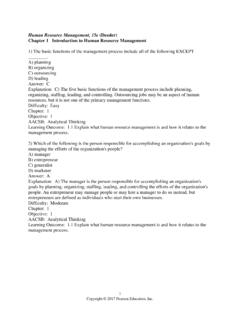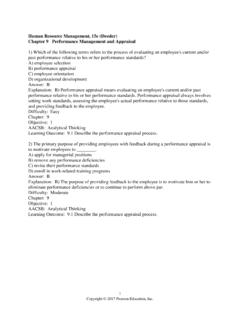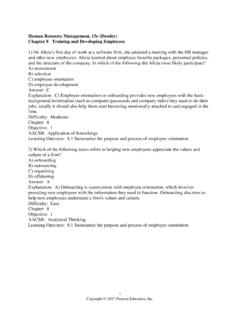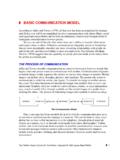Transcription of Lesson 7: Recognizing and Rewarding Performance
1 Instructor Guide Lesson 7: Recognizing and Rewarding Performance 1 DPMAP July 2016 Lesson 7: Recognizing and Rewarding Performance PURPOSE DPMAP, Lesson 7 describes the importance of Recognizing and Rewarding Performance and employee success; identify types of recognition and reward related to Performance management; and determines methods that can be utilized to recognize and reward employees. LEARNING OBJECTIVES When participants have completed Lesson 7, they will be able to: Describe the importance of Recognizing and Rewarding the employee s success. Identify types of recognition and reward related to Performance management. Determine creative ways to recognize and reward employees.
2 TIME The following is a suggested time plan for this Lesson . The instructor(s) may adapt it as needed. Note this table does not reflect breaks use your judgement to determine the timing of breaks for participants. SESSION TIME Lesson 7 - Recognizing and Rewarding Performance 80 minutes with no break Instructor Guide Lesson 7: Recognizing and Rewarding Performance 2 DPMAP July 2016 Instructor Notes Content Lesson 7: Recognizing and Rewarding Performance SAY Welcome back. We will now look at the last Lesson in the DPMAP course and that is employee reward and recognition. DO If the Lesson is being presented as a stand-alone Lesson , show all slides. If not, then consider hiding slides as appropriate.
3 SHOW SLIDE: 1 SAY These words represent the key messages that embody what is most important about New Beginnings Performance , mission, communication, excellence, etc. DO Display this New Beginnings slide at the beginning of each instructional day and during breaks. SHOW SLIDE: 2 SAY Let s review the learning objectives for this Lesson . Upon completion of this Lesson , you will be able to these things. Take a minute to read through them. Upon completion of this Lesson , you will be able to: Describe the importance of Recognizing and Rewarding the employee s success. SHOW SLIDE: 3 Instructor Guide Lesson 7: Recognizing and Rewarding Performance 3 DPMAP July 2016 Instructor Notes Content Identify types of recognition and reward related to Performance management.
4 Determine creative ways to recognize and reward employees. DO Leave this slide up while you discuss the topics that will be covered in this module. Paraphrase the learning objectives; it is not necessary to read them verbatim. SAY As you ll recall from our previous lessons, Performance management is a continual process. DO Emphasize the last bullet. SHOW SLIDE: 4 SAY DPMAP allows the flexibility to create Component-unique employee recognition and reward programs to suit the organizational differences across the Department. The broad framework of employee recognition and rewards is found in DODI , Volume 451, DoD Civilian Personnel Management Program: Awards in which monetary and non-monetary employee recognition and reward methods are addressed.
5 Examples of monetary awards (there may be others): SHOW SLIDE: 5 Instructor Guide Lesson 7: Recognizing and Rewarding Performance 4 DPMAP July 2016 Instructor Notes Content a one-time cash award a salary increase, a promotion time-off award Examples of non-monetary awards (there may be others): award plaque or challenge coin acknowledgement at a staff meeting a simple thank you or any other acknowledgement of employee s act to show it was observed and recognized Regardless of method, we must stay under the ethical spending limit guidelines under 5 CFR 2635 and DoDI , Volume 451. All awards must be deemed ethically and legally appropriate, and should be run by legal counsel prior to implementing a new award.
6 We will spend time brainstorming ideas for employee recognition and rewards that you may suggest or apply in your organization later in the Lesson . DO Be sure to note any formal training or guidance for your Component-specific reward and recognition programs. Also note that in the spirit of transparency, Components may share rating/award distribution data with the workforce. It is not a privacy issue since you would only be giving the numbers or amount of awards. Instructor Notes: Generate discussion on differences between Instructor Guide Lesson 7: Recognizing and Rewarding Performance 5 DPMAP July 2016 Instructor Notes Content employee recognition and rewards methods used daily versus and weekly.
7 SAY Employee successes and accomplishments should be recognized and rewarded Instruction: Supervisors should: Actively solicit and act on input from employees Communicate positive results based on employee input back to employees to show value of their ideas and suggestions. Verbally thank deserving employees for good Performance Give positive feedback on Performance as often as possible, when warranted Employees should: Proactively communicate successes and accomplishments to their supervisor SHOW SLIDE: 6 SAY As we discussed on the previous slide, both supervisors and employees should know the various types and methods of employee recognition and rewards specific to their Component or agency.
8 Clearly defined procedures and criteria for each type and method of SHOW SLIDE: 7 Instructor Guide Lesson 7: Recognizing and Rewarding Performance 6 DPMAP July 2016 Instructor Notes Content employee recognition and reward should be communicated and made available to all employees. This goes far in re-enforcing transparency into the employee recognition and reward process. ASK Ask: Why is this important? Potential answers include: Everyone should know how to get a reward for high Performance . Being transparent about why someone is getting an award can reduce the perception of favoritism. Transparency helps everyone believe they are capable of receiving some type of recognition or reward.
9 SAY If all employees are aware of the types and criteria of Performance recognition or reward for their organization AND the process is fair, credible, and transparent, the result will be motivated Performance by employees. DO Foster a group discussion asking the following: Can you think of an example you may have heard about or even experienced in your workplace where employee rewards or recognition did not seem fair, credible, and transparent? What are some things you have seen in your workplace that effectively supports fairness, credibility and transparency regarding employee rewards or recognition? INSTRUCTOR NOTES: Give time for discussion Instructor Guide Lesson 7: Recognizing and Rewarding Performance 7 DPMAP July 2016 Instructor Notes Content SAY Let s continue the discussion about employee recognition and reward by doing an exercise.
10 Lets form small groups. We re going to now brainstorm a list of possible employee recognition and reward methods specifically of the non-monetary type that would be available for use throughout the Performance appraisal cycle. You know that employee recognition and rewards should be an ongoing process, occurring many time over the span of the Performance appraisal cycle. Supervisors should try to maintain a variety of employee recognition and reward methods, so the same one is not used over and over again. DO Lead an Exercise: Objective: Create a list of non-monetary employee recognition and reward methods that supervisors can use throughout the Performance appraisal cycle. Instructions: Keep participants in the same small groups and have them work together to complete a list of at least 10 employee recognition and reward methods.

















